By "push pins", I assume you are referring to the pins that hold down the Northbridge heatsink?
Yes, people frequently damage SMD components on the underside of the board near the location of the northbridge.
By "push pins", I assume you are referring to the pins that hold down the Northbridge heatsink?
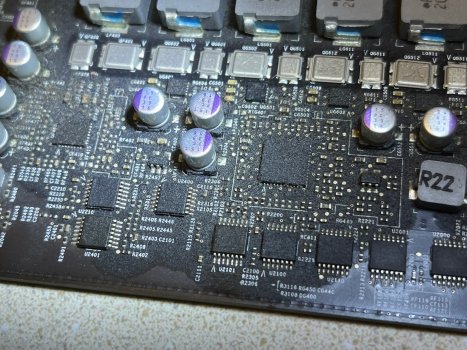

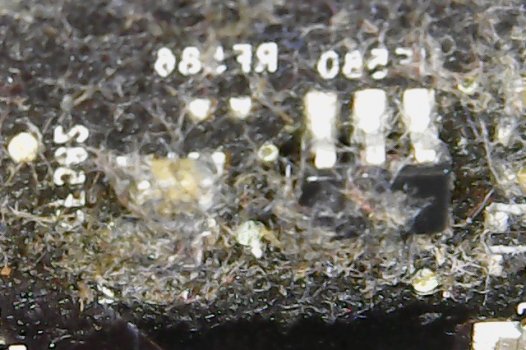
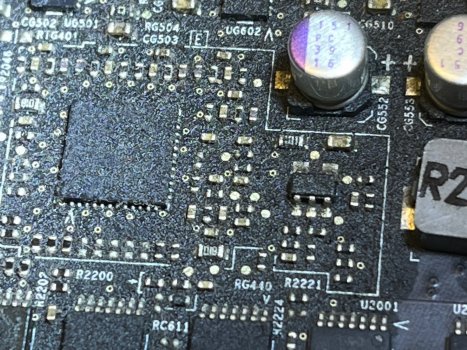
IPA won't remove all the oily residue, try kerosene/paint thinner on a small area of the PCB that have no solder mask and see what works best.I don't have the time to do the cleaning today; Mondays are generally filled with clients' emergency calls from over the weekend and this Monday is no exception. I'm assuming that 91% IPA will be sufficient; is there anything else you recommend as a cleaner?
Remove all the oily residue, clean the whole board with a brush and neutral detergent, let it dry for 24h then you put it on the oven.I realize that any use of IPA presents a risk of moisture remaining under SMCs and thought that, once I have the board clean and nominally dry, I would heat my oven to 150˚F, turn it off and place the board (on a silicone mat) in to dry. Sound OK? If I use thinner, of course, I would not dry in the oven.
It's a too expensive board to not inspect it fully, look for PCB scratches, see if no tracks are damaged, no SMD components are ripped and etc.Also, I find myself wondering: I assume I'm looking for missing, burnt or cratered components. If I DON'T find any, is there any chance of rendering this board operable?
On the other hand, if DO find them, what then? I just got a very nice Hakko soldering station and used it to replace a drone's flight controller board for a client; I'm willing (even eager) to learn but at present my skills are somewhat limited. Once having identified any offending components, is there any practical prospect of saving this board?
I'm just trying to get an idea as to where we are headed, either way, with this aspect of the project. Any words of wisdom are appreciated and carefully considered. I'll post back, probably tomorrow, with an update as to board cleaning. Should I send photos?
Thanks, tsialex!!
You need a PH neutral dishwashing liquid. Some attack metals rather harshly, don't ask why I know this.I will try to get this done today.
Would I be correct in thinking that by "neutral detergent" you mean an unscented dishwashing liquid or something of the sort?
I actually have a can of acetone; I got it for a rather delicate cleaning job but I've never used it on a PCB, fearing that it could dissolve the mask or other coatings or damage components that may have plastic in them. What is your view?
Have a great day!
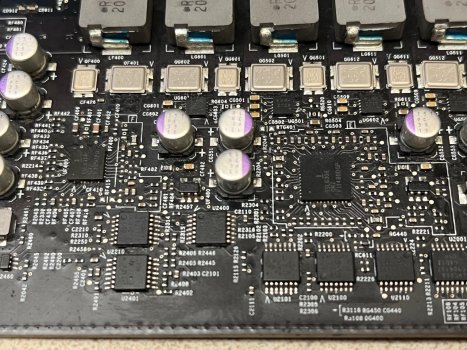
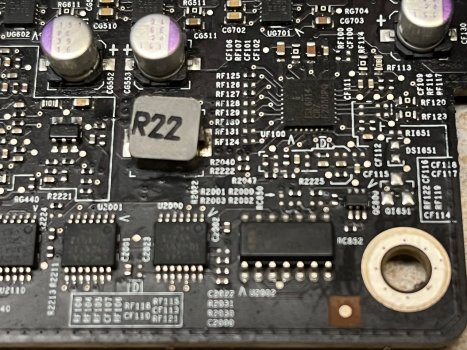
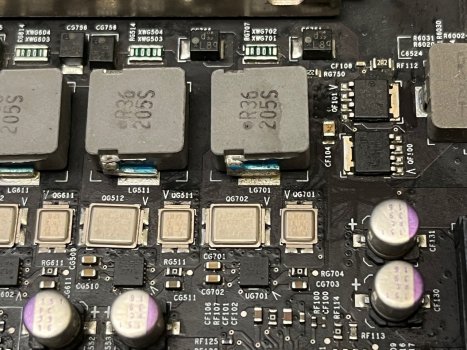
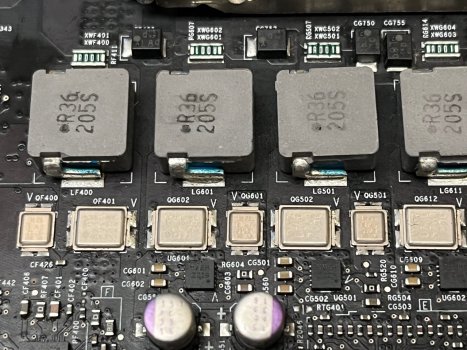
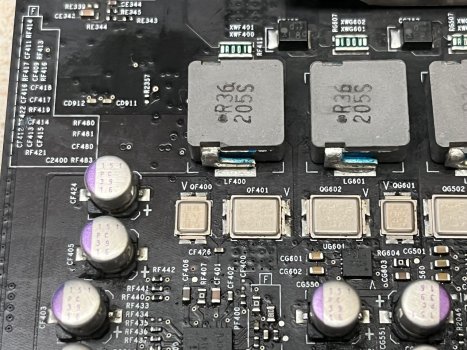


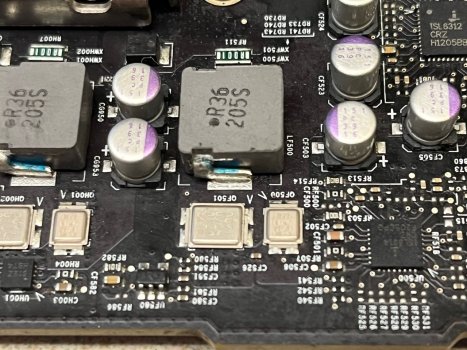
Glad that worked!!!tsialex - It's taken awhile to get back to you on this; other events have intervened, but I am now here to report some excellent news.
On Wednesday morning, I got back to the Mac Pro and inspected the CPU board again. I had noted (above) that there were one or two places that could use further cleanup. I went over the board, again, carefully scrubbing any areas that looked like they might harbor foreign matter. Then I cleaned the board and used canned, compressed air to clear away any debris and dry the surfaces. I paid particular attention to the SMCs, blowing at their bases to dislodge anything that might be harbored in or under the SMC or its pins and blow away any remaining moisture.
I let the board dry out for about 8 hours. Then I heated my oven to 170˚F. (the lowest it would go), turned it off, put the board in the oven (on a silicone mat) and left it there overnight.
Yesterday, I reassembled the board, installed it and, by George, it WORKED.
I was stunned, never having seen this before! Thank you! I have learned an important lesson. I had always assumed that the residue on PC boards was flux or other non-conductive substances used in manufacturing. I never thought that their presence would affect a board's functionality. Clearly I was wrong. In the future, I will clean boards when I run across them in this state.
I ran TechTool Pro and also the extended version of the AHT for this model; no errors were found. I did find that, when running the TechTool Pro 11's Full Suite, the system spontaneously rebooted during the "surface scan" of the SSD but I doubt that that is relevant (please correct me, if wrong). All RAM tests passed as did all the other hardware tests.
Thanks Again, tsialex!! I'm going to flash the BootROM later this afternoon. If there any other tests, diagnostics or procedures I should perform, please let me know.
You are forgetting the connectors, like the heatsink connectors on the CPU tray and the heatsink itself, male/female.Yes; it was an impressive lesson. I will never again ignore residue, etc., on a PCB.
I will flash the BootROM with the swap-out (single CPU) tray I got to test this system. Thanks for that advice.
If I understand correctly, I am to apply contact cleaner (I use CAIG Lab's "DeoxIT 5") to:
• the CPU tray socket on the backplane
• the PCI-e slots on the backplane
• the Bluetooth and AirPort sockets on the backplane
• the RAM slots on the CPU tray
Let me know if I'm missing anything. Thanks a million!
Replace the thermal paste, take utmost care with the push pins/heatsink rivets - people frequently rip SMDs/damage the PCB using pliers.Right you are. There is also a small connector between the heat sinks that connects a cable that runs to the Northbridge cooler; I'll get that too. Thanks!

I personally prefer the metal screws and nylon lock-nuts, with the original springs. Easy to find and easy to install/remove when you need to reapply the thermal paste.I read a few articles; it looks like the screws are stainless steel, buttonhead screws, 3mm x 16mm with a nylon lock-nut. The earlier articles suggest using metal and nylon washers on both sides (under board and over cooler spring) but the kit you referenced does not incorporate them. I'm thinking of using thin, nylon washers on the bottom, just to make sure that no improper contact occurs on the bottom of the board. Have you any thoughts on the matter?

